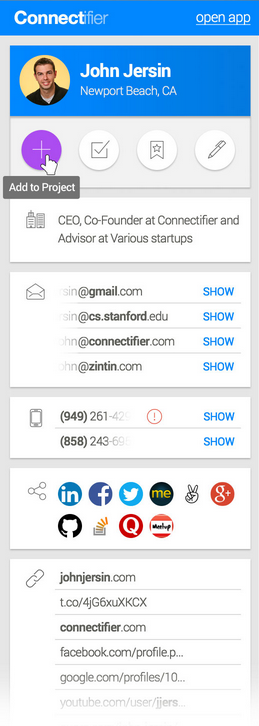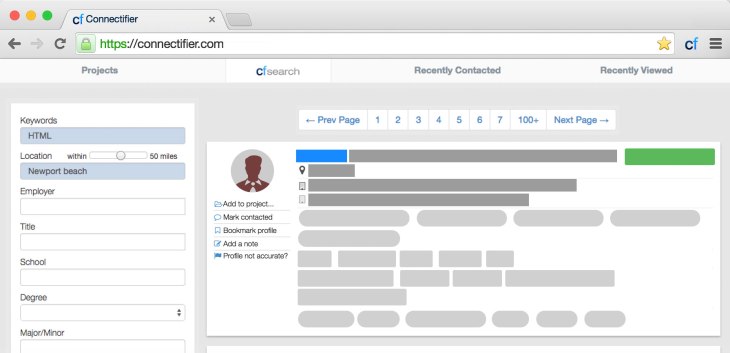Sites like LinkedIn and Monster.com have become online mainstays both for people looking for jobs and also companies looking to find the right people to fill a role. Now a new startup hopes to turn the recruitment process on its head through artificial intelligence and powerful search software that crawls across many sources at once to build up some 300 million online profiles to find the person you need.
Connectifier, as the startup is called, was founded by two ex-Google engineers, and it has already been quietly amassing a client base of tens of thousands of recruiters from top business in high tech, finance, sales, and healthcare. Today, it is publicly launching its product to the world at large, and announcing $6 million in funding led by True Ventures, with participation also from Galeo Ventures, Okapi Ventures, and angels Sean Ellis, Andrew Chen, Jonathan Downey, and James Hong.
In quiet mode, Connectifer has already seen a lot of growth in the last year, raising revenues 487 percent between Q1 2014 and Q1 2015.
The crux of the Connectifier approach to recruitment is to use big data analytics and machine learning to cut across the long tail of data on the public internet to create accurate and useful profiles of people, profiles that can be found proactively even when the individual isn’t actually looking for a new job, the essence of head hunting.
There are sites out there where people can submit their resumes for consideration by recruiters, and other sites where people can go to look for specific jobs, but no one service has figured out how to use the power of the content of the web to break through different information silos to help unearth people who might be good fits for specific roles.
There are services like Careerify, acquired by LinkedIn earlier this year, which does look at some social media data and other sources to help build profiles of users, but this doesn’t help unearth people who may not be even putting themselves out there to be discovered.
This is a problem that John Jersin, co-founder and CEO, came up against firsthand when he was at Google.
“I was leading ten engineering teams, and any time it was short staffed it was not terribly surprising, it was impossible to find the engineers we needed in the Valley,” whose need for engineers seems to mimic the water situation in California, where demand far exceeds supply. “It drove home the strategic importance of recruiting. So I dug in and tried to figure out what we could do better.”
It turned out that there hadn’t been much innovation in the space for years, “So we wanted to set out and fix this,” he said, bringing in colleague Ben McCann, a real-time analytics specialist, to build the platform with him as co-founder.
While Connectifier is young and still evolving, today the company’s product already is able to cover three areas that are black holes in the current recruitment landscape.
 The first of these is solving the issue of out-of-date information. While sites like LinkedIn are go-to places for tens of millions of people, there are millions more who have created profiles there but never update them, let alone add more data to enhance how they might be discovered by recruiters. Connectifier, which surprisingly says it doesn’t even use LinkedIn in its profile builds but instead looks across social networks, forums, and anywhere else where you might appear online, essentially crawls sites regularly to seek out the most up-to-date data about people, including how to reach them, a kind of turbo-charged Rapportive.
The first of these is solving the issue of out-of-date information. While sites like LinkedIn are go-to places for tens of millions of people, there are millions more who have created profiles there but never update them, let alone add more data to enhance how they might be discovered by recruiters. Connectifier, which surprisingly says it doesn’t even use LinkedIn in its profile builds but instead looks across social networks, forums, and anywhere else where you might appear online, essentially crawls sites regularly to seek out the most up-to-date data about people, including how to reach them, a kind of turbo-charged Rapportive.
The second of area is where AI comes into play: Connectifier has figured out a way of sorting and matching a lot of these disparate pieces of information to help create composite profiles of users. This “entity recognition” happens under the hood, so to speak, and so when a recruiter looks for a specific name or certain profile attributes of the person she or he wants to find, it’s these composite profiles that are served up as results.
The third area where Connectifier is producing interesting work is another play on the company’s AI chops. As Jersin describes it to me, you can essentially “feed” the platform information such as certain kinds of expertise, or even a piece of published writing from someone who is similar to who you would like to hire, and it will produce a list of results of people who match up with whatever parameters your provide. Think of it like Google’s image search, which may produce exact matches, but may also produce very similar images, based on whatever picture you provide.
I have to admit, as a person who thinks about how best to unearth great, undiscovered writing and journalistic talent, and as someone who probably spends more time than the average person thinking about LinkedIn and its business, all of this strikes a very strong chord with me and does indeed sound like something that really does fill a gap in the market today.
More broadly, Connectifier’s approach to harnessing and organising masses of data to create a recruitment product is what attracted its investors.
“They have taken what looked like a small problem and by using a data-driven approach have developed it into a pretty significant opportunity,” said Tony Conrad, a partner at True Ventures. He says that the startup is already cash-flow positive — another very positive (and rare) sign for a business essentially built on an software-as-a-service model.
While Jersin says that recruitment is a big enough area on its own for Connectifier to tackle without looking at other ways of applying its technology, Conrad thinks otherwise.
“I think this is a quite large idea,” he says of the technology that underpins the service. “What they are doing right now is already a big focus, but I think they are on their way to becoming a big business. They’ve figured out a technological approach that allows them to do this at scale and very intelligently. But once you have a lot of this data, can you spin that into a different and broader offering? Absolutely.”
